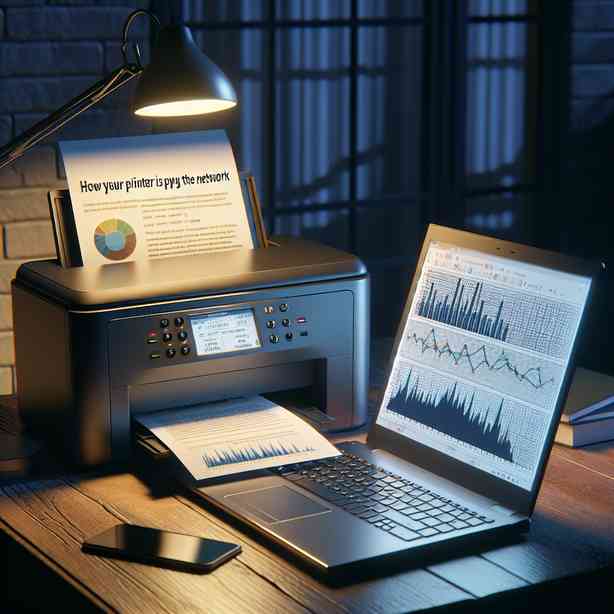
Printers are often overlooked as simple devices confined to the realm of document creation, but in our increasingly interconnected world, they have evolved into sophisticated technologies that can pose potential security risks. When we discuss how your printer might be spying on the network, it is crucial to delve into the various ways that these devices interact with your home or office network and what implications arise from this connectivity.
To begin with, modern printers are equipped with features that allow them to communicate wirelessly with other devices and user interfaces. This convenience brings a range of benefits, such as remote printing capabilities and mobile integration. However, it also exposes these printers to the same vulnerabilities faced by other networked devices. Many users underestimate how susceptible printers are to security threats due to their integration into larger networks.
Printers often have their own IP addresses, similar to computers, smartphones, and tablets. This means that they can be a potential entry point for hackers looking to infiltrate a network. Cybercriminals exploit weaknesses in the printer firmware or network protocols to gain unauthorized access. Sometimes, these devices are left unprotected, with default settings that can easily be manipulated by someone with malicious intent. If your printer is connected to a network without the proper security measures, it could potentially be seized and utilized by an attacker to extract sensitive documents or even install malware across the connected network.
One significant concern arises from the fact that many printers retain a history of the documents they print, scan, or copy. This information is stored on internal hard drives or memory, which can reveal sensitive data, including business reports, personal correspondence, and confidential documents. If a printer is sold or disposed of without a proper data wipe, any future user could access this stored data. Additionally, networked printers typically send and receive data over the network, which can be intercepted by hackers if the communication is not securely encrypted.
In the realm of data privacy, understanding how your printer manages data transactions is essential. Encryption protocols, such as IPsec or TLS, can help secure the communication between the printer and other devices on the network. Unfortunately, not all printers come equipped with robust security features. Users must educate themselves on the specific models they own and whether those devices offer up-to-date security protocols. This may require consulting manufacturer specifications, updating firmware regularly, and implementing any additional security features offered for your specific printer model.
Moreover, printers connected to public Wi-Fi networks provide another layer of risk. If anyone can connect to the same network, they may gain access to the printer without any authentication, allowing them to send malicious documents or even eavesdrop on print jobs. In environments like coffee shops or libraries, where people use networked printers, it’s common for sensitive information to be at risk. As a best practice, if you’re using a printer in a public space, avoid printing sensitive documents or ensure that the printing job is picked up immediately.
Furthermore, the operational and maintenance aspects of printers can also represent potential vulnerabilities. Many printers require regular maintenance, which often includes software updates or driver installations. If these updates are not performed regularly, a printer may fall victim to known vulnerabilities that hackers can exploit. It’s crucial to keep the printer’s firmware up to date to ensure it is protected against the latest security threats.
The integration of smart technology into printing systems has also raised concerns about privacy. Some modern printers come equipped with features that allow them to connect to the internet for cloud printing services, which can create additional exposure. Documents sent to cloud services may not always be encrypted during transmission, making them vulnerable to interception. If a printer utilizes a cloud service, users should investigate how that service manages data and what protections are in place to safeguard sensitive information.
Another concern is the potential for unauthorized remote access. Printers that support mobile printing or remote access may have inadequate security measures. Users often overlook the need to secure these features adequately. For instance, many printers can be accessed and configured via web interfaces. If a user does not change the default passwords and settings, it allows anyone on the same network to modify printer settings, view print history, or, in the worst-case scenario, deploy harmful software.
Additionally, many users may not consider the physical security of their printers. In office environments, where multiple individuals have access to shared printers, sensitive documents can easily be left unpicked at the printer’s output tray. This can lead to information leakage that may have dire consequences for both individuals and organizations. Implementing simple procedures, such as requiring passwords for printing sensitive documents, can help mitigate this risk.
Ultimately, understanding the potential risks associated with networked printers serves as a crucial step in safeguarding both personal and sensitive information. It is essential for users to review their printer’s security settings, update firmware regularly, use strong passwords, and ensure that print jobs are securely managed. These measures help reduce the likelihood of unauthorized access and protect against the potential vulnerabilities inherent in modern printing technology.
In conclusion, while printers have transformed from mere document creation tools into multifaceted devices capable of interacting extensively with digital networks, this very capability has introduced a host of security concerns. Taking proactive steps to secure your printer and being aware of the information it handles can significantly reduce the risk of being spied upon or having sensitive data compromised. As we continue to navigate an increasingly digital world, awareness and vigilance will be our best defense in ensuring that our printers serve us safely and efficiently, without compromising our privacy. It is essential to approach the use of networked printers with the same caution one would apply to any other connected device. By doing so, you can enjoy the benefits of modern printing technology while keeping your personal and professional information secure.


